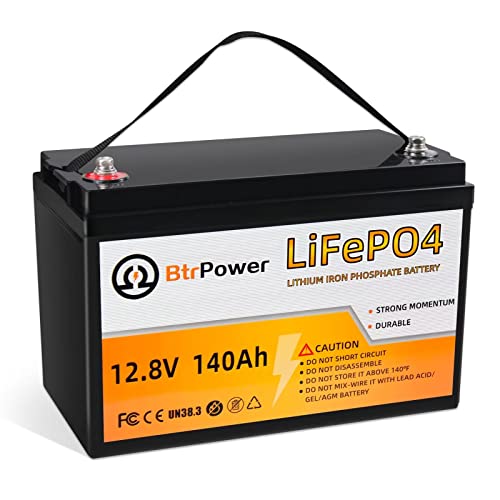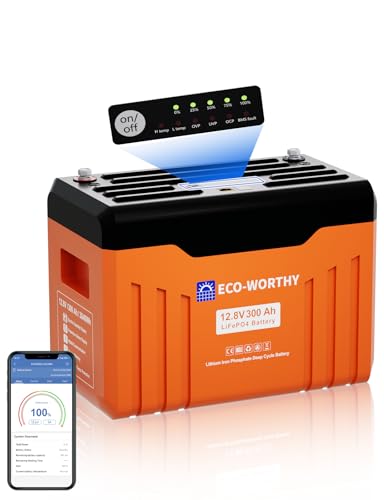Choosing the right LiFePO4 battery in 2025 isn’t just about amp-hours—it’s about reliable cycles, smart BMS protection, and practical features like Bluetooth and modular expansion. We’ll compare 12V to 48V options, from compact 10–20Ah units to 300Ah powerhouses, and note certifications that signal real safety. We’ll also flag fast-charging compatibility and cold-weather performance. Let’s see which models truly balance capacity, weight, and cost—so your RV, boat, or solar system runs without compromise.
Key Takeaways
- Prioritize LiFePO4 packs with robust BMS (100–200A), temperature cutoffs, and certifications (UL/UN38.3, CE, SGS) for safety and reliability.
- Match capacity to use: 20–10Ah for small gear, 100–150Ah for RV/boats, 300Ah+ for serious off‑grid energy storage.
- Ensure charger compatibility: use 14.6V LiFePO4 chargers; avoid 12V “desulfation” modes to protect the BMS and extend lifespan.
- Plan scalability: choose models supporting series/parallel to reach 24–48V or higher Ah; balance batteries before series setups.
- Consider extras and tradeoffs: Bluetooth monitoring, IP65 enclosures, low‑temp charge cutoffs, BMS current limits, warranties, and cycle life (2000–5000+).
2-Pack 12V 100Ah LiFePO4 Lithium Battery with Built-in BMS for RV, Marine, and Solar
October 30, 2025 12:07 pm
Looking for a lightweight, long-lasting 12V setup for RVs, boats, or off-grid solar? We like this 2-pack 12V 100Ah LiFePO4 (Group 31) with a built-in 100A BMS and IP65 protection. Each battery weighs 22.48 pounds and measures 12.9 x 6.7 x 8.6 inches—about one-third the weight of SLA/AGM. It’s energy storage, not a starter, yet handles 300A for three seconds and discharges to -4°F.
Charge correctly: use a 14.6V lithium charger, not 12V or desulfation modes. Fully charge before series use; keep voltage within 0.2V. Recharge every 2–3 months. Expect 10+ years, UL/UN38.3 safety, and a 36-month warranty.
Best For: RVers, boaters, and off‑grid solar users who need lightweight, long‑lasting 12V energy storage (not engine starting) with built‑in protection and reliable cold‑weather performance.
Pros:
- Very light for Group 31 (22.48 lbs) with high usable capacity; about one‑third the weight of SLA/AGM
- Built‑in 100A BMS with protections, IP65 water resistance, and UL/UN38.3 certified cells for safety and durability
- Long life expectancy (10+ years) and compatible with series setups when properly balanced
Cons:
- Requires a dedicated 14.6V lithium charger; 12V or desulfation modes can damage or shut down the BMS
- Not suitable for engine starting or high inrush applications like jacks or golf carts
- Must be recharged every 2–3 months during inactivity and fully balanced before series connection
12V 140Ah LiFePO4 Lithium Battery with 100A BMS (Deep Cycle, 5000+ Cycles)
October 30, 2025 1:56 pm
Serious off-grid users and RVers who need dependable deep-cycle power will appreciate this 12V 140Ah LiFePO4 battery with a built-in 100A BMS and 5000+ cycles. We get safer, non-flammable LiFePO4 chemistry with CE and SGS certifications, plus robust protection against overcharge, overdischarge, overcurrent, short circuit, and overtemperature. At just 32 lbs—about one-third the weight of lead-acid—it’s easy to install and shares dimensions with 12V 100Ah models. Expect 3–5 years of service, a flat discharge curve above 12V, low self-discharge, and full charging via solar or lithium chargers. Wire in series or parallel for 24/36/48V or up to 400Ah—ideal for RVs, boats, trolling motors, and home backup.
Best For: Off-grid homeowners, RVers, and boaters who need lightweight, safe, deep-cycle power with flexible expansion for 24/36/48V systems or higher capacity banks.
Pros:
- Long life and reliability: 5000+ cycles, LiFePO4 safety, and built-in 100A BMS with comprehensive protections.
- Lightweight and compact: 32 lbs and same size as 12V 100Ah models, easy installation and space savings.
- Flexible system design: series/parallel up to 48V or 400Ah; compatible with solar charging and lithium chargers.
Cons:
- Higher upfront cost than comparable lead-acid batteries.
- 100A BMS limits continuous current for very high-draw applications.
- 3–5 year service expectation may be shorter than some premium LiFePO4 claims depending on use conditions.
ECO-WORTHY 12V 20Ah LiFePO4 Lithium Battery with BMS
October 30, 2025 9:22 am
ECO-WORTHY’s 12V 20Ah LiFePO4 with built-in BMS stands out for ultralight portability and expandable power, making it a smart pick for kayak anglers, DIY solar tinkerers, and small-rig campers. We like its 10-year lifespan and 3000+ deep cycles—far beyond typical lead-acid. At about 5 pounds, it’s easy to stash in a tackle crate or camper cubby.
The BMS guards against overcharge, over-discharge, over-current, and short-circuit while balancing cells. Power delivery stays steady with minimal voltage drop. Chain up to four in series or go parallel for more capacity. It’s certified (UN38.3, UL 2271, CE), fits 3.03 x 7.17 x 6.69 inches, and earns broadly positive user feedback.
Best For: Kayak anglers, DIY solar builders, and small-rig campers who need a lightweight, expandable 12V power source with long cycle life and built-in protections.
Pros:
- 10-year lifespan with 3000+ deep cycles—far outlasting typical lead-acid (300–400 cycles)
- Ultralight (~5 lb) and compact; easy to mount or stash for portable rigs
- Built-in BMS for overcharge/over-discharge/over-current/short-circuit protection; can expand via up to 4 in series or unlimited parallel
Cons:
- 20Ah capacity may be insufficient for high-draw or long-duration loads without adding more batteries
- Requires LiFePO4-compatible charger for optimal performance and longevity
- Mixed-but-positive user reviews; warranty specifics require checking the product page beyond Amazon’s 30-day return window
2 Pack 12V 10Ah LiFePO4 Deep Cycle Rechargeable Batteries with 10A BMS
October 30, 2025 10:31 pm
Need a lightweight, drop-in lead-acid replacement for small 12V systems? We like this 2-pack 12V 10Ah LiFePO4 set from NERMAK. Each battery weighs just 2.64 lb (5.94 x 2.56 x 3.91 in) and packs a 10A BMS for protection against overcharge, over-discharge, over-current, and short circuit. Expect 2000+ cycles, low self-discharge, and maintenance-free storage up to a year.
Performance is solid: 10A continuous, 2C pulse, and 5A quick charge. Use them for LED lighting, scooters, fish finders, kayaks, ham radio, UPS backup, and small solar. Wire up to 4 in series or parallel. Use a LiFePO4 charger. Backed by a 12-month warranty.
Best For: DIYers and outdoor enthusiasts needing a lightweight, drop-in 12V lead-acid replacement for small loads like fish finders, scooters, LED lighting, ham radio, and backup power.
Pros:
- Long lifespan with 2000+ cycles and low self-discharge; maintenance-free storage up to 1 year
- Built-in 10A BMS for overcharge, over-discharge, over-current, and short-circuit protection
- Lightweight and compact (2.64 lb each) with flexible configuration up to 4 in series or parallel
Cons:
- Requires a LiFePO4-specific charger; some SLA chargers may not fully charge
- 10A continuous output limits use to smaller loads
- Some reports of performance degradation over time, though covered by 12-month warranty
ECO-WORTHY 12V 150Ah LiFePO4 Bluetooth Battery with BMS
October 30, 2025 5:49 am
Looking for a cold‑ready, app‑visible power upgrade for RVs, boats, or off‑grid cabins? ECO‑WORTHY’s 12V 150Ah LiFePO4 delivers 1.92 kWh in a 34.6 lb package with a 120A BMS and Bluetooth 5.0. We can monitor voltage, current, capacity, and remaining life on our phone and quickly isolate faults. The low‑temp cut‑off below -7°C (19.4°F) protects cells, making winter use safer.
It’s compact—similar volume to many 100Ah packs—but offers 150Ah. Build larger banks (4S2P or 2S4P) up to 15.36 kWh. Automotive‑grade cells and UL/IEC/CE/RoHS certifications add assurance. Ideal for trolling motors, RVs, marine, and home storage. Backed by a 3‑year warranty and responsive support.
Best For: RVers, boaters, and off‑grid users who need a lightweight, cold‑weather‑ready 12V battery with app monitoring and easy expansion into larger banks.
Pros:
- 1.92 kWh capacity in a compact 34.6 lb package; similar size to many 100Ah packs but 150Ah
- Built‑in 120A BMS with low‑temp cut‑off (-7°C/19.4°F) and Bluetooth 5.0 monitoring
- Scalable to 15.36 kWh (4S2P or 2S4P) with automotive‑grade cells and UL/IEC/CE/RoHS certifications
Cons:
- Low‑temperature charging cut‑off prevents charging below -7°C, which may limit winter charging without heating
- Bluetooth app adds complexity and depends on phone compatibility and proximity
- 3‑year warranty is decent but shorter than some competitors offering 5–10 years
12V 300Ah LiFePO4 Battery (2 Pack) for Solar, RV, and Off-Grid
October 30, 2025 1:56 pm
Serious off‑grid builders and RVers who want deep reserves without babysitting will appreciate this 12V 300Ah LiFePO4 2‑pack from Dumfume, delivering 3840Wh with a robust 200A BMS and 4S4P expandability to 48V. We like its safe LiFePO4 chemistry, full BMS protections, and automatic high/low‑temp cutoffs. Each unit weighs about 57 lbs, yet the ABS housing shrugs off heat, weather, and impacts. Expect up to 4000 cycles at 100% DOD, or around 15,000 at 60%—a decade of service. It’s ideal for RVs, off‑grid solar, and backup power. Charge/discharge every six months. Warranty and returns apply; support is responsive.
Best For: Off‑grid homeowners and RV/camper enthusiasts who need high‑capacity, low‑maintenance LiFePO4 storage with robust BMS protection and expandability to 48V.
Pros:
- High energy reserve: 12V 300Ah per battery (2‑pack) delivering 3840Wh with a 200A BMS and 4S4P scalability to 48V systems
- Long lifespan and safety: up to 4000 cycles at 100% DOD (15,000 at 60%), LiFePO4 chemistry, full BMS protections, and automatic high/low‑temperature cutoffs
- Durable and practical: impact/heat/weather‑resistant ABS housing; manageable ~57 lb per unit for installation in RVs and off‑grid setups
Cons:
- Weight still significant for some installs; handling ~57 lb per unit may require two people
- Listed total weight inconsistency (121.4 lbs vs. ~114 lbs for 2 units) may cause confusion
- Requires periodic maintenance cycling (charge/discharge every 6 months) and potential 1–5% voltage/current deviation after temperature/humidity stress tests
NOCO Lithium NLX31 12V LiFePO4 Battery (120Ah Deep-Cycle, 1600A Starter)
October 30, 2025 1:56 pm
For buyers who want one battery to both crank hard and run deep, NOCO’s Lithium NLX31 stands out with 1,600A peak starting power and a true 120Ah LiFePO4 reserve. We like its Group 31 footprint, 37.9-pound weight, and quad-post terminals that fit SAE, threaded, and button connectors. Expect up to 2x the usable capacity of similar lead-acid, plus rapid charging: 50A in about 2.4 hours (25A ~4.8, 10A ~12). The BMS covers temp, voltage, and current with over/under protections and passive balancing. It’s IP65 rugged, UL listed, series/parallel ready (up to four), and rated 2,000–6,000 cycles depending on depth.
Best For: Buyers who need a single Group 31 battery that can both deliver strong engine cranking (1,600A peak) and provide deep-cycle power (true 120Ah) for marine, RV, overland, and off-grid systems.
Pros:
- Dual-purpose performance: 1,600A starting plus 120Ah LiFePO4 deep-cycle with up to 2x usable capacity vs. similar lead-acid
- Fast, flexible charging and long life: 50A ~2.4h full, with 2,000–6,000 cycle lifespan depending on depth of discharge
- Rugged and versatile: IP65 enclosure, quad-post terminals for SAE/threaded/button, series/parallel up to 4, UL listed
Cons:
- Higher upfront cost than comparable AGM/lead-acid options
- 200A continuous discharge may limit very high-draw inverter applications without multiple batteries
- Requires compatible lithium charging profile to maximize performance and longevity
ECO-WORTHY 12V 300Ah LiFePO4 Lithium Battery with Bluetooth and 200A BMS
October 30, 2025 1:56 pm
Need a high-capacity 12V pack you can actually monitor in real time? ECO-WORTHY’s 12V 300Ah LiFePO4 delivers 3,840Wh per unit with Bluetooth app control and a 200A BMS. We get live SOC, voltage, current, cycle count, and temps, plus LED status at a glance. The BMS safeguards against high/low voltage, overload, and temperature extremes; it blocks charging below -7°C and sounds a buzzer for faults.
At 60.4 lbs and 16.3 x 8.46 x 10.24 inches, it installs easily and weighs far less than lead-acid. Scale to 30.7kWh via 4P2S or 2P4S. Ideal for RVs, off-grid solar, and home backup with longer life and quicker troubleshooting.
Best For: RV owners, off-grid solar users, and home backup builders who need a high-capacity 12V LiFePO4 battery with real-time Bluetooth monitoring and robust 200A BMS protection.
Pros:
- 3,840Wh per unit with Bluetooth app for live SOC, voltage, current, cycle count, and temperature data
- 200A BMS with high/low voltage, overload, and low-temp charge protection (blocks charging below -7°C) plus fault buzzer
- Scalable to 30.7kWh (4P2S or 2P4S), lighter than lead-acid at 60.4 lbs, and easy to install
Cons:
- Low-temperature charge cutoff at -7°C may require external heating in cold climates
- Bluetooth monitoring depends on the ECO-WORTHY app and device proximity
- Single 12V format may need series/parallel configurations for higher voltage systems, adding wiring complexity
12V 330Ah LiFePO4 Battery with 200A BMS & Bluetooth for RV, Solar, Off-Grid
October 31, 2025 12:24 am
Looking to power an RV or off-grid setup without babysitting your battery? We like this 12V 330Ah LiFePO4 with a built-in 200A BMS and Bluetooth. It delivers up to 8,000 deep cycles and a 10+ year lifespan, using EVE Grade A+ cells and excellent balancing for stable voltage. At 57 pounds and 9.64D x 13.58W x 7.48H, it packs strong energy density (78 Wh/lb vs similar 300Ah). Pair in series or parallel, integrate with solar, and monitor capacity and status in real time via app. Protections cover over/under-charge, overload, short, and temps. Use a 14.6V 50A charger. UL/IEC/CE/RoHS certified with a 5-year warranty.
Best For: RV owners and off-grid users who want a high-capacity, low-maintenance LiFePO4 battery with robust protection, Bluetooth monitoring, and long cycle life.
Pros:
- Large 330Ah capacity with up to 8,000 cycles and 10+ year lifespan; EVE Grade A+ cells and strong cell balancing for stable voltage
- Built-in 200A BMS with comprehensive protections and Bluetooth app for real-time monitoring
- Flexible setup: supports series/parallel, solar integration; solid energy density at 78 Wh/lb for its class
Cons:
- Requires a specific lithium charger (14.6V, ideally 50A) to charge properly
- Low-temperature cutoff below -4°F may restrict charging/usage in very cold climates without heating
- Heavier and larger than smaller-capacity LiFePO4 options at 57 lbs and 9.64D x 13.58W x 7.48H
NOCO Lithium NLX27 12V LiFePO4 Battery (100Ah Deep-Cycle, 1400A Starter)
October 30, 2025 1:56 pm
Serious starters who also deep-cycle their systems will appreciate the NOCO NLX27: a UL-listed, dual-purpose 12V LiFePO4 that pairs 1,400A peak cranking with a true 100Ah capacity. We get Group 27 drop-in convenience and a quad-post layout for series or parallel links up to four batteries. Expect twice the usable capacity of lead-acid, steady voltage delivery, and up to 2x faster charging.
A 50A charge rate tops it off in about two hours. The bidirectional BMS handles balancing and protects against overcharge, overdischarge, and shorts, with active thermal monitoring—no resets. An IP65, honeycomb-reinforced shell resists vibration, water, and dust. Versatile posts fit autos, marine, RVs, and off-grid.
Best For: Power users who need a UL-listed, dual-purpose 12V battery that can both start high-draw engines and reliably deep-cycle for marine, RV, off-grid, and car audio setups with fast recharging.
Pros:
- 1,400A peak and 175A continuous output deliver strong starting performance plus true 100Ah deep-cycle capacity with steady voltage.
- Up to 2x usable capacity and 2x faster charging vs. comparable lead-acid; 50A charging achieves full recharge in ~2 hours.
- Quad-post Group 27 drop-in with versatile terminals supports series/parallel configurations up to four batteries; IP65 rugged, vibration-resistant build.
Cons:
- Requires compatible lithium charging profile; some legacy lead-acid chargers or systems may need adjustments or replacement.
- Higher upfront cost than lead-acid despite longer lifecycle and performance gains.
- Group 27 size and 50A recommended charge current may not suit very small systems or limited-charge-source setups.
Factors to Consider When Choosing Lithium Lifepo4 Batteries
Let’s zero in on what matters most: matching battery capacity to our load, respecting discharge rate limits, and confirming the built-in BMS protects against over/under-voltage, temperature, and short circuits. We’ll also check charging voltage compatibility with our charger to avoid reduced performance or damage. Finally, we’ll set realistic cycle life expectations based on depth of discharge and usage patterns.
Battery Capacity Needs
How much capacity do we really need from a LiFePO4 battery? We start with ampere-hours (Ah), which tells us how long a load can run. Higher Ah means longer runtime at the same draw. Unlike many lead-acid packs that only deliver about half their label, LiFePO4 typically lets us use 90%+ depth of discharge, so a 100Ah pack reliably provides most of that capacity.
If we’re building a bank, remember how sizing scales: parallel adds Ah, series adds voltage. For 24V or 48V systems, we’ll select modules designed for series/parallel so total voltage and Ah meet our target while staying within the BMS and charger specs.
Real-world runtime also shifts with discharge rate; higher current reduces effective capacity, though LiFePO4 holds voltage well.
Discharge Rate Limits
Capacity sets how long we can run, but discharge limits decide what we can power at once. Each LiFePO4 battery lists a maximum discharge current—often 100A or 200A—to protect cells and preserve cycle life. We should match that limit to our peak loads, not just daily energy needs.
Manufacturers also rate safe draw as a C‑rate. A 100Ah battery at 1C can deliver 100A continuously; pushing 2C doubles current but accelerates wear if used often. Some packs allow short surge currents—say 300A for a few seconds—but sustained high draw increases heat and reduces usable capacity.
When building series or parallel banks, we must keep the pack’s total discharge within the ratings of every cell and the system’s protections to prevent imbalance and safety issues.
Built-In BMS Features
Why does the built‑in BMS matter so much? Because it’s the battery’s brain and bodyguard. A good BMS shields LiFePO4 cells from overcharge, overdischarge, overcurrent, and short circuits, while monitoring temperature and enforcing low‑temp charge cutoffs. That protection preserves cycle life and prevents downtime.
We also look for smart balancing. Automatic cell balancing keeps voltages uniform without tinkering, and premium packs tout active or bidirectional balancing for faster, more precise equalization across cells. That translates to fuller usable capacity and steadier performance over time.
Match the BMS’s maximum discharge rating to your loads. If a pack is rated for 100A or 200A and you exceed it, the BMS may trip and shut down. Clear specs and robust protections mean fewer surprises and safer power.
Charging Voltage Compatibility
Ever wondered why some “12V” chargers don’t work with LiFePO4? It’s because LiFePO4 needs a precise charge voltage: 14.6V ±0.2V. A generic 12V output won’t properly activate or fully charge the pack. We should always pair these batteries with a LiFePO4-specific charger that targets the correct absorption voltage and avoids lead-acid repair or desulfation modes, which can trigger BMS shutdowns or cause damage.
The BMS and cells rely on that tight charging window to prevent overcharge and protect lifespan. In series systems, we also need closely matched cell or pack voltages—differences should stay within 0.2V—to maintain balance during charging. Many packs specify a maximum of 14.6V and may require a lithium-activation routine on arrival. Check specs, set chargers accordingly, and avoid “repair” modes.
Cycle Life Expectations
Curious how long a LiFePO4 will actually last? Let’s set clear expectations. Cycle life typically ranges from about 2,000 to over 15,000 cycles, driven mostly by how deep we discharge and how we use the pack. At 100% depth of discharge, many quality batteries claim roughly 4,000–6,000 cycles, and LiFePO4 loses capacity more slowly at deep discharges than other chemistries.
We can stretch longevity by aiming for moderate depth of discharge—around 50–80%—which often boosts cycle counts substantially. In real-world terms, that translates to a practical lifespan of 3–10+ years with proper charging and routine care. Low, stable self-discharge helps during downtime, as long as we follow sensible recharge intervals. Bottom line: match DoD to your usage, and you’ll maximize years and cycles.
Temperature Operating Range
How much does temperature really matter with LiFePO4? It matters a lot. These batteries handle a wide operating range, but performance changes with ambient conditions. In extreme cold, available capacity drops and many BMSs cut charging below roughly -7°C (19.4°F), or even -4°F on some models, to prevent damage. That low‑temperature protection helps avoid lithium plating by stopping charge when cells are too cold.
We should check the manufacturer’s recommended windows: many allow charging down to 0°C (32°F) and discharging across a broader range. High heat is the other risk—without control, elevated temperatures accelerate aging. Fortunately, modern BT/BMS monitoring uses temperature sensors to modulate charge and discharge, protecting the pack. Expect reduced usable capacity at temperature extremes, and plan charging accordingly to preserve longevity.
Series/Parallel Expandability
While capacity and cycle life grab attention, series/parallel expandability often decides whether a LiFePO4 battery fits our system today and scales tomorrow. We look for packs that clearly support up to 4S for higher voltage banks and multiple units in parallel (2P, 4P) to boost amp-hours for RVs, solar storage, or off‑grid loads. Parallel raises capacity at the same voltage; series raises voltage at the same capacity.
Before series connections, we top-balance modules so voltages match within 0.2V to avoid imbalance. We also confirm the manufacturer’s max configurations—24V, 36V, 48V, or total Ah limits—and use a LiFePO4‑specific charger, not an SLA charger. Equally important, the BMS must coordinate modules, handling multi-pack balancing and current limits to prevent overcurrent, overcharge, or thermal faults.
Size and Weight Constraints
When we spec a LiFePO4 bank, size and weight set real-world limits on what we can lift, mount, and cool. LiFePO4 typically cuts weight to about one-third to one-quarter of equivalent lead-acid, which helps handling and axle loads in RVs. A 12V 100–150Ah module usually lands around 22–34 pounds and measures roughly 12–14 inches long, 6–8 wide, and 6–9 high—dimensions that decide whether a battery fits an existing bay or needs a new enclosure.
Stepping up, 300–330Ah units can approach 57 pounds, so racks and mounting points must support concentrated mass. To scale capacity or voltage without unwieldy modules, we’ll use series/parallel banks of manageable units. Higher energy density and low self-discharge reduce total footprint for seasonal setups, minimizing storage space and ventilation needs.
Conclusion
We’ve covered the best LiFePO4 batteries of 2025, from compact 10Ah packs to powerhouse 300–330Ah units with Bluetooth and robust BMS protection. Whether we’re outfitting an RV, a boat, or an off‑grid cabin, these picks deliver thousands of cycles, fast charging, and dependable safety. Choose capacity, voltage, and expandability to match your system—and verify certifications. With the right battery, we’ll power adventures like it’s 1999, only smarter, safer, and lighter than ever.












